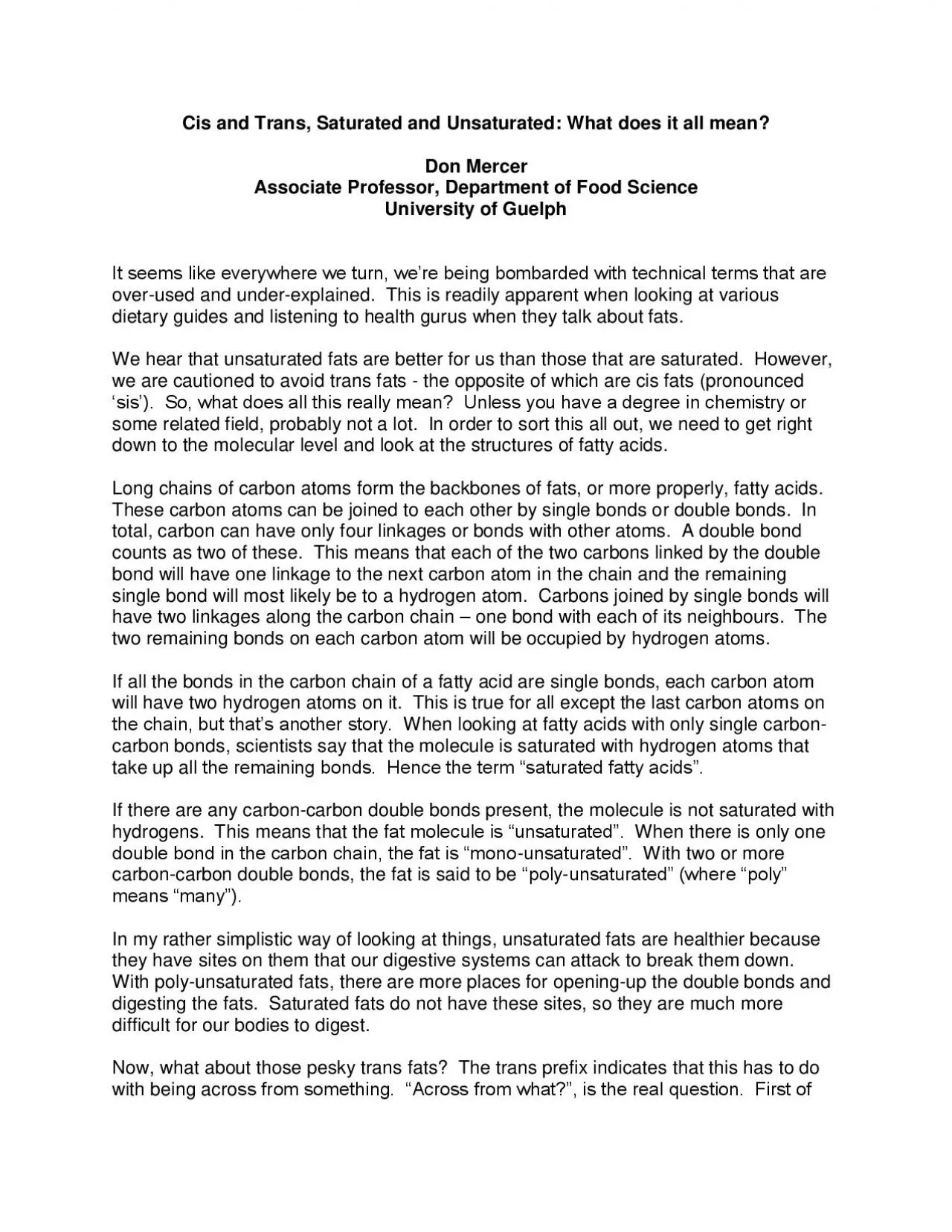

What does it all mean Don Mercer Associate Professor Department of Food Science University of Guelph It seems like everywhere we turn were being bombarded with technical terms that are over ID: 954542
Download Pdf The PPT/PDF document "Cis and Trans Saturated and Unsaturated" is the property of its rightful owner. Permission is granted to download and print the materials on this web site for personal, non-commercial use only, and to display it on your personal computer provided you do not modify the materials and that you retain all copyright notices contained in the materials. By downloading content from our website, you accept the terms of this agreement.
Cis and Trans, Saturated and Unsaturated : What does it all mean? Don Mercer Associate Professor, Department of Food Science University of Guelph It seems like everywhere we turn, we’re being bombarded with technical terms that are over - used and under - explained. This is readily apparent when looking at various dietary guides and listening to health gurus when they talk about fats . We hear that unsaturated fats are better for us than those that are saturated. However, we are cautioned to avoid t rans fats - the opposite of which are cis fats (pronounced ‘sis’). So, what does all this really mean? Unless you have a degree in chemistry or some related field, probably not a lot. In order to sort this all out, we need to get right down to the molec ular level and look at the structures of fatty acids. Long chains of carbon atoms form the backbones of fats, or more properly, fatty acids. These carbon atoms can be joined to each other by single bonds or double bonds. In total, carbon can have only f our linkages or bonds with other atoms. A double bond counts as two of these. This means that each of the two carbons linked by the double bond will have one linkage to the next carbon atom in the chain and the remaining single bond will most likely be t o a hydrogen atom. Carbons joined by single bonds will have two linkages along the carbon chain – one bond with each of its neighbours. The two remaining bonds on each carbon atom will be occupied by hydrogen atoms. If all the bonds in the carbon chain of a fatty acid are single bonds, each carbon atom will have two hydrogen atoms on it. This is true for all except the last carbon atom s on the chain, but that’s another story. When looking at fatty acids with only single carbon - carbon bonds, scientists say that the molecule is saturated with hydrogen atoms that take up all the remaining bonds. Hence the term “saturated fatty acids”. If there are any carbon - carbon double bonds present, the molecule is not saturated with hydrogens. This means that the f at molecule is
“unsaturated”. When there is only one double bond in the carbon chain, the fat is “mono - unsaturated”. With two or more carbon - carbon double bonds, the fat is said to be “poly - unsaturated” (where “poly” means “many”). In my rather simplist ic way of looking at things, unsaturated fats are healthier because the y have sites on the m that our digestive systems can attack to break them down. With poly - unsaturated fats , there are more places for opening - up the double bonds and digesting the fats. Saturated fats do not have these sites, so they are much more difficult for our bodies to digest. Now, what about those pesky trans fats? The trans prefix in dicates that this has to do with being acro ss from something. “Across from what?”, is the real question. First of all, trans fats are unsaturated fats that contain at least one carbon - carbon double bond. The carbon atom on each end of the double bond will have a single hydrogen atom sticking off to the side. If these hydrogen atoms are on opposite sides of the carbon chain, then we have a trans fatty acid. That’s where the sense of being across comes into play. When these two hydrogen atoms are on the same side of the fatty acid’s carbon chain backbone, we have a cis fatty acid. For reasons that are too involved to explain in a short article such as this, trans fats are the bad guys when it comes to diseases of the coronary arteries. Fortunately for us, most naturally occurring fatty acids have the cis configuration. It’s usually when the fats are hydrogenated to modify their behaviour that the trans forms are produced. The take - away message in all this is to minimize your intake of trans fats and avoid saturated fats. H opefully, you no w have a bit more insight into what the terms actually mean that will help dispel some of the mystery concerning these important components of the foods we eat. These diagrams show the saturated and unsaturated forms of fatty acids, along with examples of their cis and trans fats